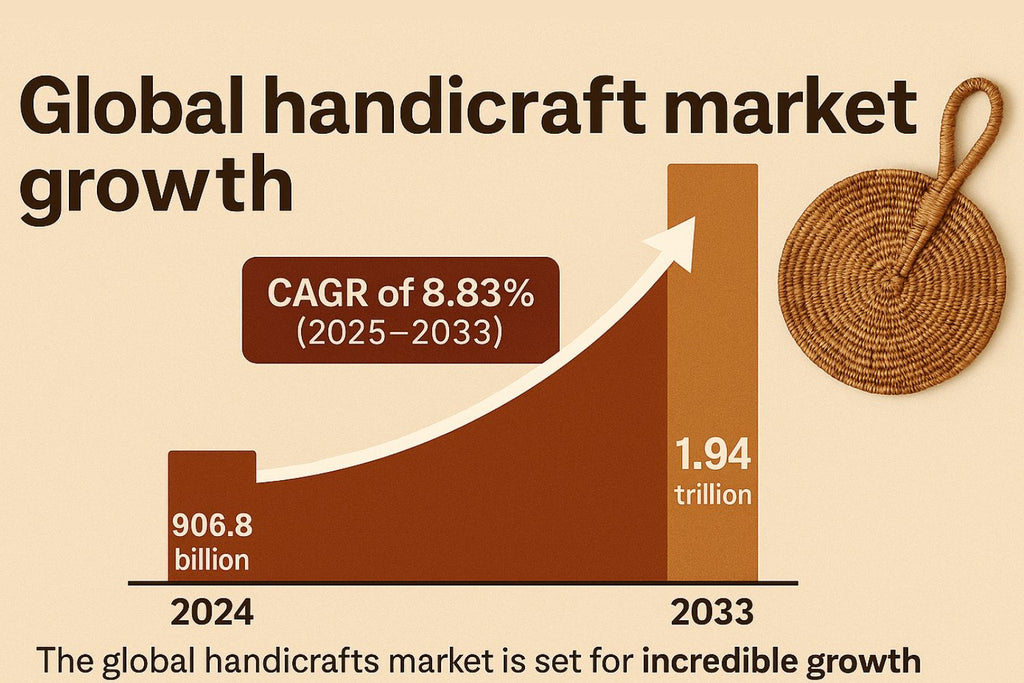Why the Handicrafts Market is Surging Towards $1.94 Trillion in 2033

The global handicrafts market is set for incredible growth. According to a recent report from ResearchAndMarkets.com, the market will grow from $906.8 billion in 2024 to $1.94 trillion by 2033, showing a compound annual growth rate (CAGR) of 8.83% during 2025-2033.
And in the U.S. alone, the handicrafts market, which was worth $294.4 billion in 2023, is predicted to more than double, hitting $627.5 billion by 2032 (Fortune Business Insights).
This is a golden opportunity for independent artisans and small business owners like me who specialize in handcrafted goods. The market is growing because more and more people want things made by real hands.
I’ll be sharing why handmade items are popular now and what this means for artisans, hobbyists, and full-time makers who sit down every day and create with their hands.
The growing interest in handmade goods
I don’t see the rise in handmade as a trend; it feels more like a shift in how people are thinking about the world around them. More of my customers are asking questions about where things come from, how they’re made, and whether they’re good for the planet.
Climate change has made people look harder at what they buy. They don’t want to keep piling up cheap things that break quickly and end up in the bin.
The report I mentioned earlier explains that the surging demand for unique handmade goods is one of the top drivers of this market growth.
You can feel it in the way younger buyers shop. I’ve noticed that Gen Z and Millennials, especially, are more likely to ask about the artisans who make my products and the communities they support.
They want their money to support something they believe in, whether that’s fair pay for artisans or using natural fibres over synthetic ones. For them, handmade allows them to live according to their values.
Related: This is how Bolga baskets are made!
Sustainability is pushing people toward handicrafts

Most of us are more aware of how our choices affect the planet. And the good news is, the handmade industry often works in harmony with the environment.
In my business, I take pride in explaining to my clients how my woven baskets and artifacts use natural, renewable materials and support craftspeople in different parts of Africa. They last longer, use less energy to make, and avoid the waste and pollution that comes with factory-made goods.
The research backs this up. One study noted that eco-conscious consumers are helping push handicrafts into the spotlight, especially products made with recycled or sustainable materials, or through small-scale, low-impact processes.
With climate concerns growing, more people are making intentional purchases, and that includes supporting artisans who work in sustainable ways.
E-commerce and digital platforms have made the world smaller for artisans
This is another massive factor in the growth. When I started selling online, I didn’t expect to have customers from across the UK—let alone from different parts of Europe and even the US.
But with platforms like Etsy, Shopify, Instagram, and even Pinterest, the barriers that used to keep artisans local have basically disappeared. For instance, handmade items are one of the most popular items sold on Etsy.
Handmade sellers now have access to international audiences without needing a storefront in every country. According to the data, this rise in digital marketplaces is one of the main reasons the handicrafts market is growing so fast.
In the US alone, the handicrafts market is projected to grow to $627.5 billion by 2032. And it's not just the US—Asia Pacific currently leads with over 36% of the market share, showing that this trend is global.
And it goes without saying that handmade crafts have played a role in Africa’s economic development.
What the future looks like for artisans

With the market expected to almost double in less than a decade, I decided to talk about why the handicrafts market is surging towards $1.94 trillion in 2033 because there’s room for more artisans to step forward, whether you're selling from a small shop, through an online marketplace, or just starting out.
There’s more opportunity than ever before to build a businessaround handmade goods. The projected expansion to $1.94 trillion by 2033 means more people valuing the work we do and the traditions we preserve.
Also, customers are willing to pay more for products with meaning, quality, and sustainability. If you're an artisan or run a small handmade business, these statistics are a signal.
The internet is your marketplace —no matter where you live. It’s never been easier for artisans or for small business owners like me to reach a global audience, thanks to e-commerce and social media.
Storytelling is a powerful tool to share how things are made, who made them, and why it matters. People care. I love sharing the story behind a handmade basket or doll because I think it helps me build a relationship with loyal customers who keep coming back. And now that the world is paying attention to artisans and handmade products, I truly believe the time is now.
If you're interested in supporting artisans and adding unique handcrafted pieces to your home, I invite you to browse my collection of handwoven baskets and other artifacts at Rufina Designs. Each purchase not only brings beauty and functionality to your space but also supports traditional craftsmanship and sustainable practices.





